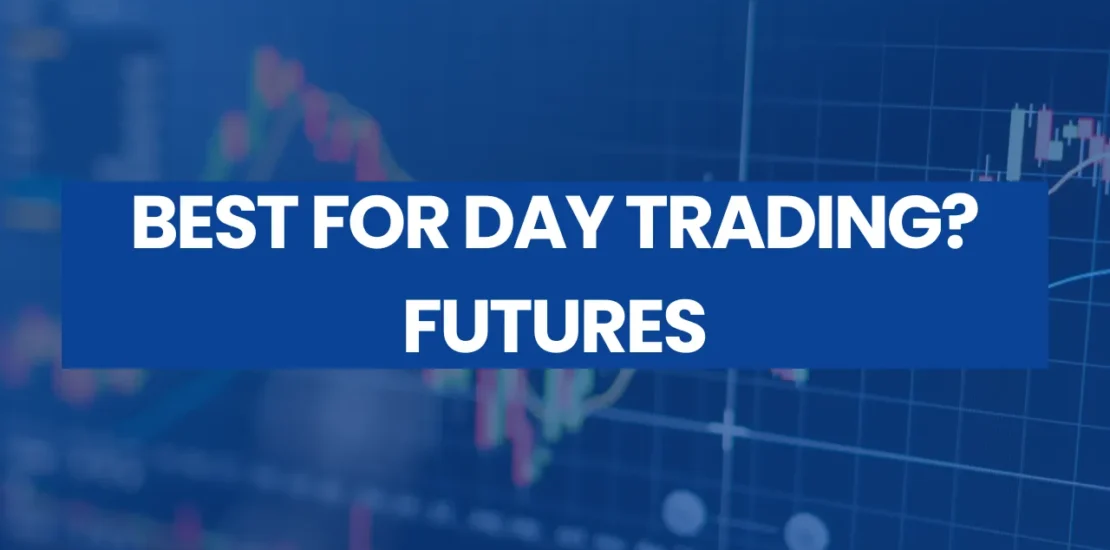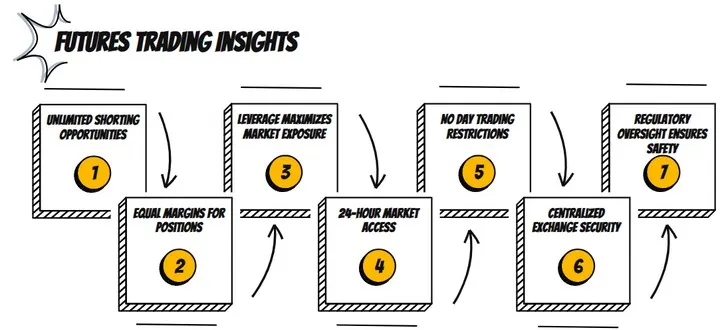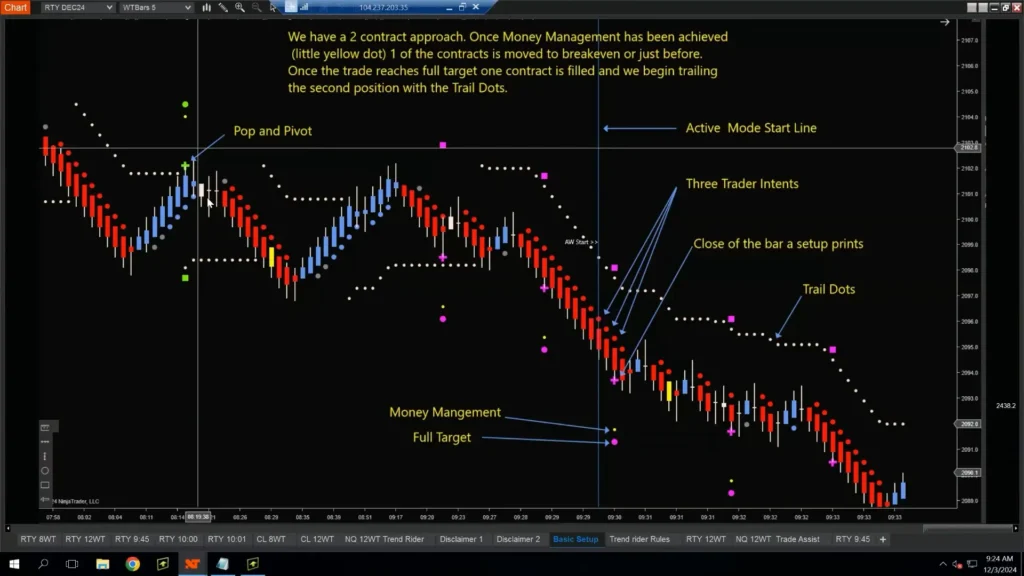- February 6, 2025
- Posted by: CoachShane
- Categories: Day Trading, Futures Trading, Trading Article

Futures trading is an ideal choice for day traders due to its unique combination of advantages. The ability to short without restrictions, improved leverage through lower margins, and 24-hour market access create great trading flexibility.

Day traders particularly benefit from the absence of pattern day trading rules and the security of centralized exchanges, allowing for frequent position-taking without typical stock market limitations.
Freedom to Short Without Limitations
Freedom in futures trading is true when it comes to shorting positions, setting it apart from traditional stock market constraints. Unlike stocks, where short selling can face restrictions or outright bans during market volatility, futures traders enjoy unrestricted access to shorting opportunities, allowing them to react fast to market conditions.
Another very popular approach to day trading is 0DTE Options! Download your FREE guide!
The simplified process of shorting futures eliminates the need to borrow assets, making it as straightforward as entering a sell order. This accessibility, combined with the centralized nature of futures markets, enables traders to execute market reaction strategies more efficiently. Like the 9 EMA crossover signals that traders watch for potential trend reversals, timing plays a important role in successful short trades just as in long positions.
Day traders benefit from the equal initial deposit requirements for both long and short positions, creating a level playing field regardless of trade direction. The high liquidity in futures markets further ensures smooth entry and exit points for short positions. With leverage ratios ranging from 1:2 to 1:12, traders can maximize their market exposure while maintaining smaller capital requirements.
Increased Trading Power With Lower Margins
Three key advantages of futures trading that are clear through its improved margin structure, allowing traders to control substantial market positions with relatively modest capital requirements.
- Increased leverage: Traders can control substantial market positions with relatively modest capital requirements, typically 3-12% of the contract’s notional value
- Enhanced capital efficiency: Day trading margins often require significantly less capital than standard equity positions, allowing traders to maximize market exposure
- Greater trading flexibility: The competitive margin structure enables traders to take advantage of more trading opportunities with limited funds
The margin dynamics in futures trading enable traders to access higher funding, with day trading margins often requiring significantly less capital than standard equity positions. For instance, while E-mini S&P futures may require nearly $17,000 in initial margin, day trading margins can drop to as low as $500 per contract. Margins can be very different when comparing brokers.
These capital rules creates powerful opportunities for traders, though proper risk management remains essential. Successful traders focus on position sizing to maintain appropriate risk parameters while maximizing market exposure.
The competitive margin structure not only boosts trading power but also demands disciplined trading approaches. Day traders can maximize their market exposure while balancing the double-edged nature of funding, which can amplify both profits and losses.
Unlike options trading where premium costs can reduce profit potential, futures trading offers direct market exposure without additional fee barriers beyond commissions.
Round-the-Clock Market Access and Liquidity
Beyond the capital advantages of futures trading, the marketplace offers unparalleled accessibility through nearly continuous trading hours and strong liquidity.
| Futures Market | Best Trading Times (EST) | Key Characteristics |
|---|---|---|
| Equity Index Futures (S&P 500, NASDAQ) | 9:30 AM – 11:30 AM | Highest liquidity, market opening volatility |
| 3:00 PM – 4:00 PM | Closing hour volatility, institutional positioning | |
| Energy Futures (Crude Oil, Natural Gas) | 9:00 AM – 11:30 AM | Peak pit trading session, strong volume |
| 1:30 PM – 2:30 PM | Institutional position closing | |
| Forex Futures | 8:00 AM – 12:00 PM | London/New York market overlap |
| Agricultural Futures | 9:30 AM – 1:15 PM | CBOT regular trading hours |
| Cryptocurrency Futures | 24/7 trading | Continuous market, high volatility |
Today’s electronic trading platforms enable market participants to execute their trading strategies at virtually any time, breaking free from traditional market hours constraints.
This “round-the-clock access” means traders can optimize their market timing based on global events and price movements across different time zones.
The increased liquidity in futures markets makes it easier to enter and exit positions quickly, while the interconnected nature of these markets ensures that traders can react instantly to economic developments worldwide.
For day traders specifically, this combination of extended hours and liquidity provides the flexibility to trade when opportunities come up according to the trading strategy, regardless of where you live.
Successful traders often focus on accumulation zones where large market participants gather positions, creating potential trading opportunities.
Traders can improve their success by identifying confluence zones where multiple technical indicators align to confirm potential entry and exit points.
Unrestricted Trading Frequency for All Account Sizes
Unlike stock trading’s stringent pattern day trading rules, the futures market offers traders exceptional flexibility in their trading frequency, regardless of account size. This freedom allows traders to develop their trading psychology naturally, without the stress of monitoring trade counts or maintaining minimum account balances.
Traders can execute multiple positions throughout the day, focusing on market analysis rather than regulatory constraints. The absence of pattern day trading restrictions means participants can enter and exit positions based purely on market conditions and their trading strategy.
Additionally, the flexible margin requirements and unrestricted short-selling capabilities enable traders to implement diverse trading approaches effectively.
When combined with round-the-clock market access, this trading freedom creates an environment where traders can fully express their market views without artificial constraints. Understanding personal risk tolerance is essential for sustainable futures trading success.
However, traders should remember that risk capital limitations are important when implementing any futures trading strategy, as losses can exceed initial investments.
Secure Trading Through Centralized Exchanges
While futures trading offers extraordinary profit potential, the security infrastructure of centralized exchanges provides essential protection for traders’ assets and market integrity.

These exchanges operate under strict regulatory oversight from both the CFTC and SEC, implementing strong security protocols and conducting regular security audits to identify potential vulnerabilities.
Through centralized clearinghouses, trades are automatically guaranteed, significantly reducing counterparty risk and ensuring seamless market operations.
Asset protection measures include advanced cybersecurity systems, regulatory compliance frameworks, and transparent reporting requirements.
Understanding support and resistance zones helps traders deal with price movements more effectively within this secure exchange environment.
The standardized nature of futures contracts, combined with the exchanges’ commitment to market stability, creates an environment where traders can focus on their strategies rather than worrying about the safety of their investments.
This comprehensive security framework makes futures trading particularly attractive for day traders seeking reliable market access.
Implementing a 2% risk limit per trade helps traders maintain sustainable account balances while operating within these secure exchange environments.
Your Questions Answered
What Strategies Work Best for Managing Emotional Stress During Futures Day Trading?
Successful traders implement mindfulness techniques, maintain strict risk management protocols, and utilize stress reduction methods like meditation. Following predetermined trading plans helps minimize emotional decision-making during market volatility.
How Long Does It Typically Take to Become Profitable in Futures Trading?
Becoming profitable in futures trading typically requires 6-12 months of dedicated practice. The learning curve varies by individual, and realistic profit expectations should account for market conditions and strategy development.
Which Futures Markets Are Most Suitable for Beginners to Start Trading?
E-mini S&P 500 and Micro E-mini futures contracts offer beginners high liquidity, extended trading hours, and manageable capital requirements. Treasury futures provide stable opportunities with lower volatility.
What Software Platforms Are Recommended for Futures Day Trading Analysis?
Popular trading software platforms include TradingView, NinjaTrader, and Sierra Chart, offering comprehensive charting tools, real-time data analysis, and customizable indicators for effective futures day trading operations.
How Do Futures Trading Commissions Compare to Stock Trading Commissions?
Futures trading commissions vary widely among brokers and depend on factors such as trading volume and contract type. Here are some common commission rates for trading futures:
Low end: $0.19 to $0.25 per side for high-volume traders
Mid-range: $0.75 to $0.99 per side for regular traders
High end: Up to $2.25 per side with some brokers
